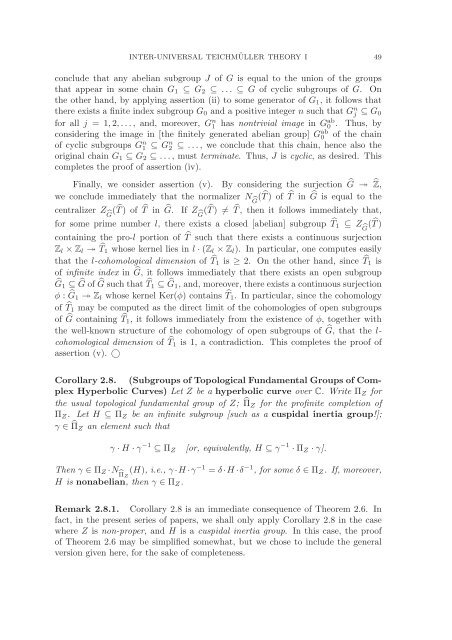Inter-universal Teichmuller Theory I: Construction of Hodge Theaters
Inter-universal Teichmuller Theory I: Construction of Hodge Theaters
Inter-universal Teichmuller Theory I: Construction of Hodge Theaters
You also want an ePaper? Increase the reach of your titles
YUMPU automatically turns print PDFs into web optimized ePapers that Google loves.
INTER-UNIVERSAL TEICHMÜLLER THEORY I 49<br />
conclude that any abelian subgroup J <strong>of</strong> G is equal to the union <strong>of</strong> the groups<br />
that appear in some chain G 1 ⊆ G 2 ⊆ ... ⊆ G <strong>of</strong> cyclic subgroups <strong>of</strong> G. On<br />
the other hand, by applying assertion (ii) to some generator <strong>of</strong> G 1 , it follows that<br />
there exists a finite index subgroup G 0 and a positive integer n such that G n j ⊆ G 0<br />
for all j =1, 2,..., and, moreover, G n 1 has nontrivial image in G ab<br />
0 . Thus, by<br />
considering the image in [the finitely generated abelian group] G ab<br />
0 <strong>of</strong> the chain<br />
<strong>of</strong> cyclic subgroups G n 1 ⊆ G n 2 ⊆ ..., we conclude that this chain, hence also the<br />
original chain G 1 ⊆ G 2 ⊆ ...,mustterminate. Thus, J is cyclic, as desired. This<br />
completes the pro<strong>of</strong> <strong>of</strong> assertion (iv).<br />
Finally, we consider assertion (v). By considering the surjection Ĝ ↠ Ẑ,<br />
we conclude immediately that the normalizer NĜ( ̂T )<strong>of</strong> ̂T in Ĝ is equal to the<br />
centralizer ZĜ( ̂T )<strong>of</strong> ̂T in Ĝ. If ZĜ( ̂T ) ≠ ̂T , then it follows immediately that,<br />
for some prime number l, there exists a closed [abelian] subgroup ̂T 1 ⊆ ZĜ( ̂T )<br />
containing the pro-l portion <strong>of</strong> ̂T such that there exists a continuous surjection<br />
Z l × Z l ↠ ̂T 1 whose kernel lies in l · (Z l × Z l ). In particular, one computes easily<br />
that the l-cohomological dimension <strong>of</strong> ̂T 1 is ≥ 2. On the other hand, since ̂T 1 is<br />
<strong>of</strong> infinite index in Ĝ, it follows immediately that there exists an open subgroup<br />
Ĝ 1 ⊆ Ĝ <strong>of</strong> Ĝ such that ̂T 1 ⊆ Ĝ1, and, moreover, there exists a continuous surjection<br />
φ : Ĝ1 ↠ Z l whose kernel Ker(φ) contains ̂T 1 . In particular, since the cohomology<br />
<strong>of</strong> ̂T 1 may be computed as the direct limit <strong>of</strong> the cohomologies <strong>of</strong> open subgroups<br />
<strong>of</strong> Ĝ containing ̂T 1 , it follows immediately from the existence <strong>of</strong> φ, together with<br />
the well-known structure <strong>of</strong> the cohomology <strong>of</strong> open subgroups <strong>of</strong> Ĝ, that the l-<br />
cohomological dimension <strong>of</strong> ̂T 1 is 1, a contradiction. This completes the pro<strong>of</strong> <strong>of</strong><br />
assertion (v). ○<br />
Corollary 2.8. (Subgroups <strong>of</strong> Topological Fundamental Groups <strong>of</strong> Complex<br />
Hyperbolic Curves) Let Z be a hyperbolic curve over C. Write Π Z for<br />
the usual topological fundamental group <strong>of</strong> Z; ̂Π Z for the pr<strong>of</strong>inite completion <strong>of</strong><br />
Π Z . Let H ⊆ Π Z be an infinite subgroup [such as a cuspidal inertia group!];<br />
γ ∈ ̂Π Z an element such that<br />
γ · H · γ −1 ⊆ Π Z<br />
[or, equivalently, H ⊆ γ −1 · Π Z · γ].<br />
Then γ ∈ Π Z ·N̂ΠZ<br />
(H), i.e., γ ·H ·γ −1 = δ ·H ·δ −1 ,forsomeδ ∈ Π Z . If, moreover,<br />
H is nonabelian, thenγ ∈ Π Z .<br />
Remark 2.8.1. Corollary 2.8 is an immediate consequence <strong>of</strong> Theorem 2.6. In<br />
fact, in the present series <strong>of</strong> papers, we shall only apply Corollary 2.8 in the case<br />
where Z is non-proper, andH is a cuspidal inertia group. Inthiscase,thepro<strong>of</strong><br />
<strong>of</strong> Theorem 2.6 may be simplified somewhat, but we chose to include the general<br />
version given here, for the sake <strong>of</strong> completeness.
















